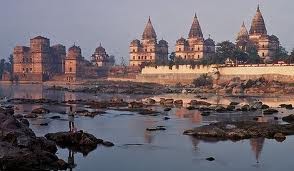
Legend has it that the name of the city come from that of an ascetic, Gvâlipa, which would have healed a Rajput raja, Surâj Sen of leprosy.
The latter would then founded the city in gratitude.
Gwalior is the hometown of Mian Tansen, one who is considered one of the greatest Indian musicians of all time and was court musician of Akbar.
His mausoleum is in the city.
Gwalior, which houses a number of historic buildings, is located on a rocky platform overlooking the city and measures 2. 4 km in its greatest length, from north to south and 820 m in its greatest width. The platform rises to 104 m at its northern end. A wall surrounds the fort that can be reached by a steep road. The Citadel, located northeast of the enclosure, is a beautiful building of yellow stone, decorated with glazed tiles of land containing images with animal decorations, especially an amazing frieze of ducks.
Several noteworthy temples were built within the enclosure.  The group of Sas-Bahu, for example, built in 1093 by the Raja and his brother Padmapâla Mahipala,
perhaps originally dedicated to Vishnu, is dedicated to worship Jain.
The largest - 33 x 21 meters - has lost its roof while the other, has retained its pyramidal roof.
Both contain a central hall with four pillars. The Teli-ka-Mandir - Temple of oil merchant -
dates from the eleventh century and underwent a renovation in the nineteenth century.
Probably dedicated to Surya, it became afterwards one Jaina temple.
It was later dedicated to Vishnu in before becoming a Shiva temple in the fifteenth century.
The group of Sas-Bahu, for example, built in 1093 by the Raja and his brother Padmapâla Mahipala,
perhaps originally dedicated to Vishnu, is dedicated to worship Jain.
The largest - 33 x 21 meters - has lost its roof while the other, has retained its pyramidal roof.
Both contain a central hall with four pillars. The Teli-ka-Mandir - Temple of oil merchant -
dates from the eleventh century and underwent a renovation in the nineteenth century.
Probably dedicated to Surya, it became afterwards one Jaina temple.
It was later dedicated to Vishnu in before becoming a Shiva temple in the fifteenth century.
One of the curiosities of the fort is a set of Jain caves, hundreds of them of various sized excavated in the cliff in the part where the route climbs to the upper platform. Most of them form a niche around the statue which has been excavated, but some are of such a size that could be a cell designed to accommodate a Jain ascetic, very common in whole of India. According to an inscription, work which produced this set of caves would have been conducted on thirty years in the fifteenth century. One of the statues excavated 17 meters high, making it the largest in North India.
The Man Mandir Palace, built by Man Singh (1486-1516), shows an interesting example of the architectural work of that time in Hindu India.
He has continued to be enlarged at the end of its construction and until the seventeenth century, especially by the Mughal emperors Jahangir and Shah Jahan.